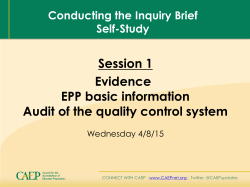
Preparing the Self-Study
Preparing the Self-Study Patty Garvin & Nate Thomas, CAEP CONNECT WITH CAEP |www.CAEPnet.org| Twitter: @CAEPupdates Analyze Sufficiency & Quality of Evidence Council Present Evidence & Supporting Narrative Site Visitors EPP Purpose of the Self-Study Report Source of Evidence CONNECT WITH CAEP |www.CAEPnet.org| Twitter: @CAEPupdates Updated Self-study Template Will be available soon! CONNECT WITH CAEP |www.CAEPnet.org| Twitter: @CAEPupdates Timeline Action Timeframe Submit Transformation Initiative Proposal ~ 5 years prior to visit Submit EPP-created assessments for formative review (optional) & SPA Review 3 years prior to visit EPP selects visit date (coordinate with state agency) 18 months prior to preferred visit date EPP solicits third party testimony 6-8 months prior to visit EPP submits Self-Study Report 8 months prior to visit EPP receives Formative Feedback Report 4 months prior to visit EPP submits Self-Study Addendum 60 days prior to visit CONNECT WITH CAEP |www.CAEPnet.org| Twitter: @CAEPupdates Advanced Programs • The CAEP Board of Directors will be considering a clarification of the scope for the Advanced Program Standards at the June 2015 CAEP Board meeting. • Any EPP submitting a self-study before fall 2017, using the 2013 CAEP Initial Program Standards, will not include evidence for Advanced level programs. • There will be a transition and phase-in schedule included in the Accreditation Manual for Advanced Programs released in fall 2016. CONNECT WITH CAEP |www.CAEPnet.org| Twitter: @CAEPupdates Purpose of Capacity Tables Provide Context for Reviewers – programs offered and structure of EPP Provide data for CAEP's Annual Report to the Public Satisfy requirements of the US Department of Education CONNECT WITH CAEP |www.CAEPnet.org| Twitter: @CAEPupdates Capacity Tables* 1. Institutional Accreditation 2. Program Characteristics 3. EPP Characteristics 4. Clinical Educator Qualification Table 5. Parity Table 6. Accreditation Plan * under review CONNECT WITH CAEP |www.CAEPnet.org| Twitter: @CAEPupdates Tagging Evidence – No More Guess Work Aligns evidence to a specific standard or component. Points the team directly to what they need to see. Strengthens the EPP’s case. CONNECT WITH CAEP |www.CAEPnet.org| Twitter: @CAEPupdates Tagging Evidence - Rubric CONNECT WITH CAEP |www.CAEPnet.org| Twitter: @CAEPupdates Tagging Evidence – Data Chart CONNECT WITH CAEP |www.CAEPnet.org| Twitter: @CAEPupdates Tagging Evidence - Policy CONNECT WITH CAEP |www.CAEPnet.org| Twitter: @CAEPupdates Tagging Evidence - Agenda CONNECT WITH CAEP |www.CAEPnet.org| Twitter: @CAEPupdates Make your case • Use a summary statement to make a case for meeting the standard based on evidence • Case is made at the standard level holistically • All components must be addressed in the standard Required for Full Accreditation – Standard 4 and Components 3.2, 5.3, 5.4 CONNECT WITH CAEP |www.CAEPnet.org| Twitter: @CAEPupdates Writing the Narrative • Frame the argument to be made for a standard • Describe the data sources (representativeness, relevance, and credibility for the standard) • Draw a conclusion about the extent the data support the standard (triangulation and convergence of evidence) • Discuss implications of the findings for subsequent action CONNECT WITH CAEP |www.CAEPnet.org| Twitter: @CAEPupdates Themes of Diversity & Technology • Highlight and present evidence of integration of diversity and technology • Standards 1, 2, and 3 have specific components related to diversity and technology • Visit team will analyze evidence of diversity and technology integration CONNECT WITH CAEP |www.CAEPnet.org| Twitter: @CAEPupdates Type of plans • CAEP Standards may require new evidence not collected in the past Providers submit a plan in lieu of unavailable data to gather needed evidence Phase-in policy applies to self-studies submitted from 2014 – 2017 (Appendix A, page 84) • Recruitment Plan required (Standard 3) • Selected Improvement Plan or Transformation Initiative Plan required to show continuous improvement (Standard 5) CONNECT WITH CAEP |www.CAEPnet.org| Twitter: @CAEPupdates Recommended Plan Components • Goals and Objectives • Strategies • Data Collection and Analysis • Timeline • Personnel Involved CONNECT WITH CAEP |www.CAEPnet.org| Twitter: @CAEPupdates Standard 5: Provider Quality Assurance and Continuous Improvement Component 5.3 : “The provider regularly and systematically assesses performance against its goals and relevant standards, tracks results over time, tests innovations and the effects of selection criteria on subsequent progress and completion, and uses results to improve program elements and processes.” Component 5.4: “Measures of completer impact, including available outcome data on P-12 student growth, are summarized, externally benchmarked, analyzed, shared widely, and acted upon in decision-making related to programs, resource allocation, and future direction.” CONNECT WITH CAEP |www.CAEPnet.org| Twitter: @CAEPupdates The Selected Improvement Plan (SIP) EPPs demonstrate progress in achieving a higher level of excellence in educator preparation by developing and using a data-driven SIP. CONNECT WITH CAEP |www.CAEPnet.org| Twitter: @CAEPupdates 1. Description of the selected area for improvement and rationale What and Why? Selected Area: • One or more standards. • Several components within a standard, or • Several components across more than one standard. Rationale: • Derived from the provider’s existing evidence collection for meeting the standards. • Natural extension of the evidence collection. CONNECT WITH CAEP |www.CAEPnet.org| Twitter: @CAEPupdates 2. Goals and objectives Where do you want to go? • Appropriate and aligned with the selected area • Specific and measurable • Involve all provider programs • Identify desired outcomes and indicators of success • Demonstrate that meeting the goals and objectives will have a positive impact on P-12 learners • Have their selection grounded in data CONNECT WITH CAEP |www.CAEPnet.org| Twitter: @CAEPupdates 3. Strategies for Interventions How will you get there? • Identify specific strategies and/or initiatives • Strategies and/or initiatives are aligned with goals and objectives of the plan • Yearly timeline for meeting goals and/or objectives • Plan for the evaluation and monitoring of strategies and/or interventions • Evaluation and monitoring are linked to goals and objectives CONNECT WITH CAEP |www.CAEPnet.org| Twitter: @CAEPupdates 4. Data collection and analysis How will you know you are there? • Assessment instruments or method to be used • How the assessments were selected or created • How each assessment links back to goals and objectives • On-going monitoring of the assessment plan • How assessment results will be analyzed to determine impact based on baseline data CONNECT WITH CAEP |www.CAEPnet.org| Twitter: @CAEPupdates 5. Capacity to implement and complete plan • Describe potential cost in terms of provider staff time and commitment to the project • Provider and staff time and commitment to the project • Describe potential cost in terms of travel or training cost • Describe potential cost in terms of expertise (outside evaluation or consulting fees) • Identify other key costs of implementing the SIP CONNECT WITH CAEP |www.CAEPnet.org| Twitter: @CAEPupdates Guidelines for the SIP • Of sufficient scope to have a positive impact on the provider and the performance of its candidates. • The goals, objectives, and timeline must be appropriate to the selected area of improvement. • Show progress on the SIP in the Annual Reports. • Make changes to the SIP when data indicate. • Begin a SIP and related interventions at any time during the accreditation cycle. CONNECT WITH CAEP |www.CAEPnet.org| Twitter: @CAEPupdates Evaluation of the SIP • Selected area alignment and rationale for selection driven by self-study • Goals and objectives are identified and align with selected area. • Strategies for intervention • Data collection and analysis • Capacity to implement and complete plan • Overall evaluation of the SIP CONNECT WITH CAEP |www.CAEPnet.org| Twitter: @CAEPupdates Transformation Initiative Plan (TIP) A provider develops and conducts a rigorous research investigation of an aspect of educator preparation described in a Transformation Initiative Plan (TIP). Implementation of the plan will contribute to the research base, inform the profession, offer researchproven models for replication, and lead to stronger practices in preparation. CONNECT WITH CAEP |www.CAEPnet.org| Twitter: @CAEPupdates Evaluation of the TIP • Significance of the project • Research questions & objectives • Methodology & Participants • Research Design • Timeline • Plan for IRB approval (if necessary) • Broad stakeholder involvement • Capability to implement and complete Contact Nate Thomas for consultation on TI CONNECT WITH CAEP |www.CAEPnet.org| Twitter: @CAEPupdates Engaged feedback is vital to CAEP. You will have an opportunity to complete a survey at the end of the conference. Surveys will be sent via email on Friday, April 10. We encourage your participation. Thank you. CONNECT WITH CAEP |www.CAEPnet.org| Twitter: @CAEPupdates
© Copyright 2025




















